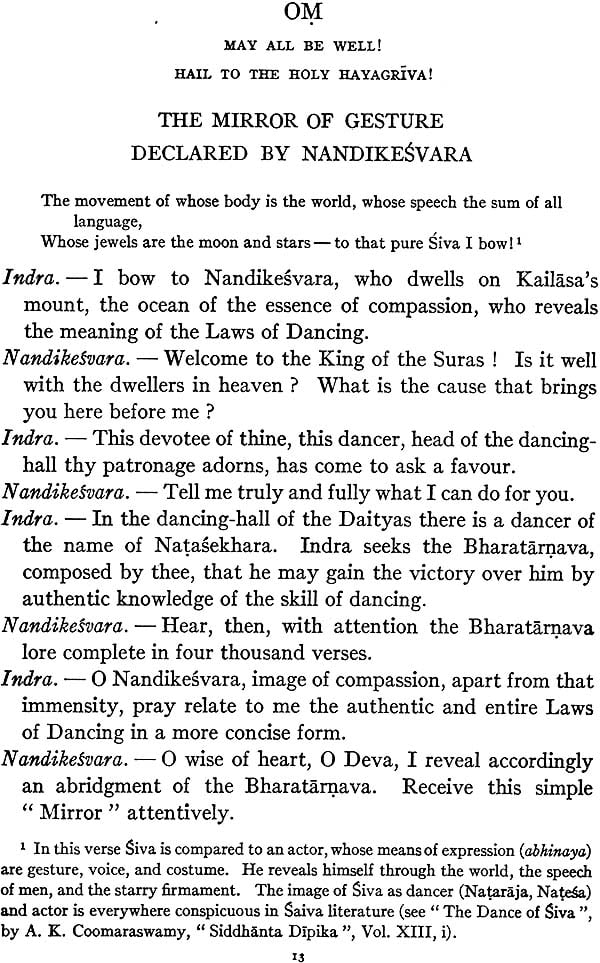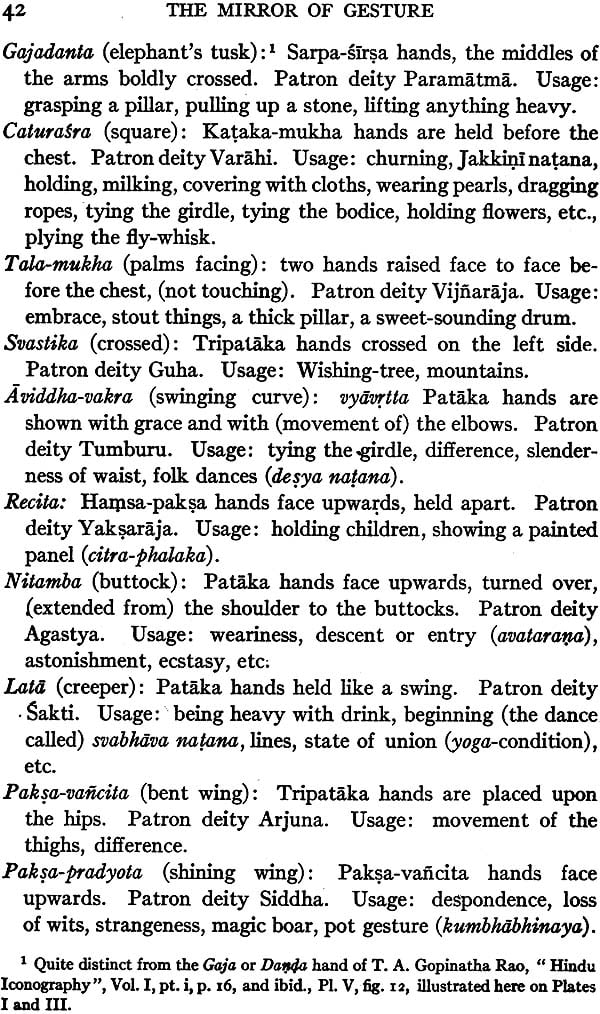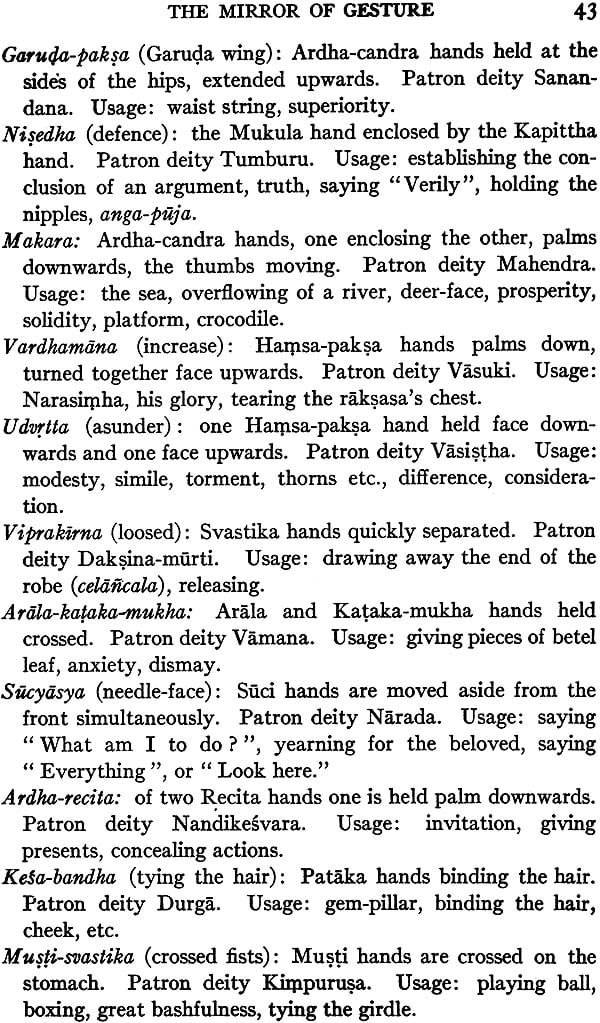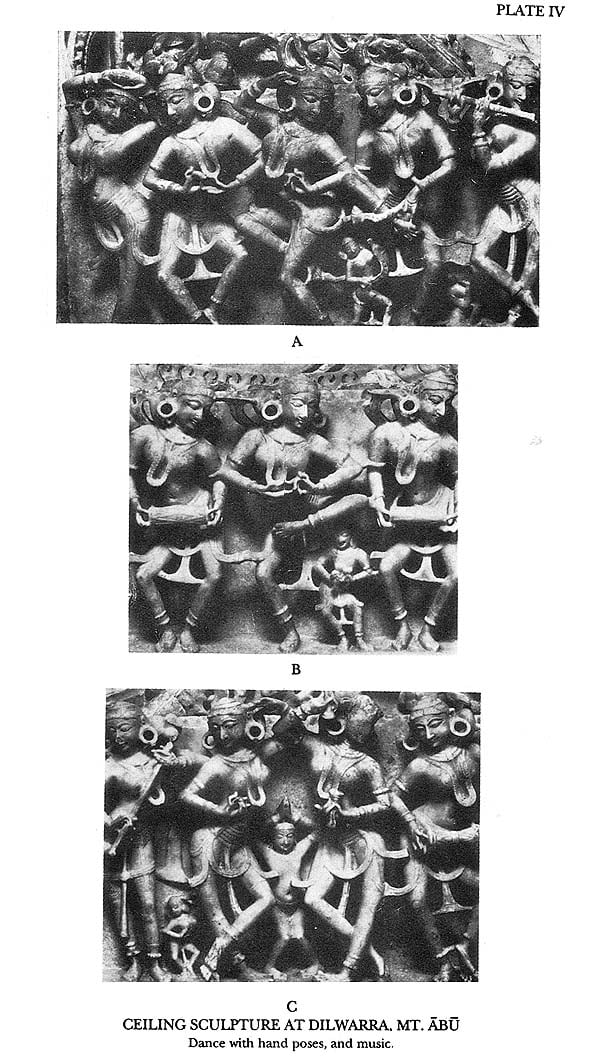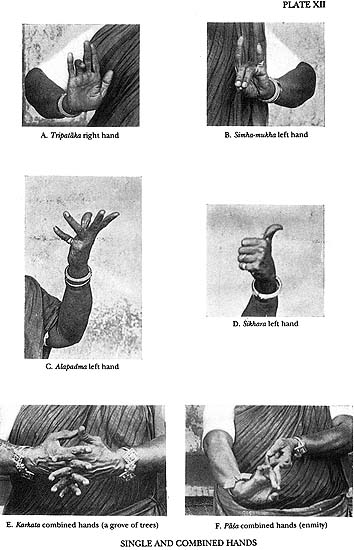
The Mirror of GestureBeing the Abhinaya Darpana of Nandikesvara
Book Specification
| Item Code: | IMD21 |
| Author: | Trans. Into English by Ananda K. Coomaraswamy and Gopala Kristnayya Duggiralla |
| Publisher: | MUNSHIRAM MANOHARLAL PUBLISHERS PVT LTD |
| Language: | English |
| Edition: | 2019 |
| ISBN: | 9788121500210 |
| Pages: | 60 (with ills) |
| Cover: | Hardcover |
| Other Details | 8.5" x55" |
| Weight | 180 gm |
Book Description
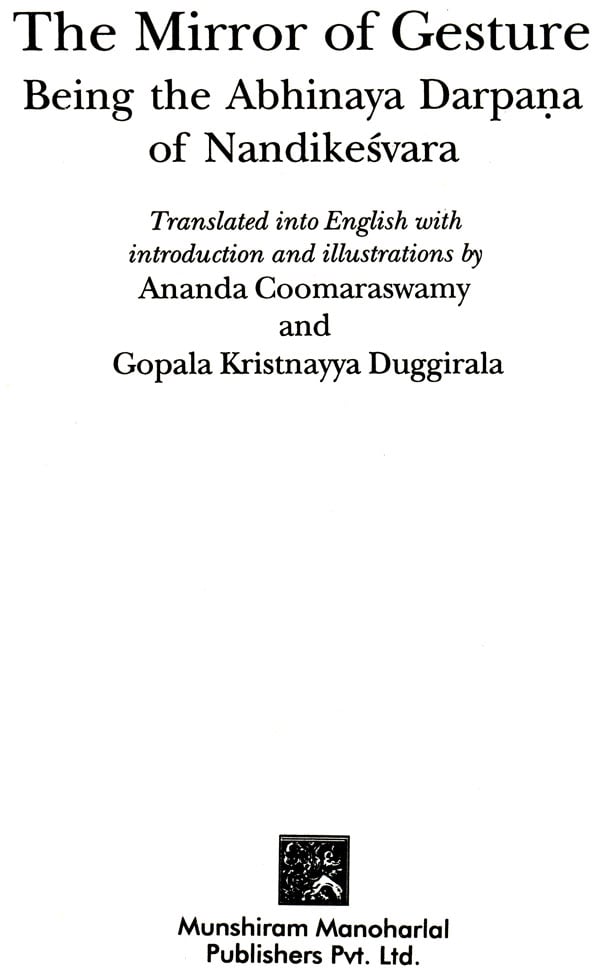
From the Jacket
The Mirror Gesture is the English translation of the Abhinaya Darpana of Nandikesvara which was originally published with a Telugu interpretation by Madabhushi Tiruvenkatachari of Nidamangalam in 1984. The Abhinaya Darpana, according a Nandikesvara, who is a legendary figure, is an abridgement of the Bharatarnava, an exposition on the art of dancing.
For those not acquainted with the Indian dramatic technique, it may be difficult to understand the importance of such texts. However, as coomaraswamy has pointed out, this work may be of immense interest to the living actor in the European theatre and will not only be profitable for him "to adopt the actual gesture language of the East, but it may inspire him with the enthusiasm and the patience needful for the re-creation of the drama in his own environment. "This book, which will serve as an introduction to the Indian dramatic technique and its essentials which imply not merely a through understanding of the natya, nrtta and nrtya but also the conditioning aesthetic qualities of rasa, bhava etc.
Indian acting and dancing, which are, in fact, dovetailed, possess a special hieratic significance and can be understood by a cultivated audience. In general, however, natya also corresponded to the common and collective need of the folk.
To those interested in a study of Indian arts in general, the present manual is of great importance. Gesture, as a means of conveying and interpreting ideas extends beyond the stage into the domains plastic art, painting and statuary. The mudra, an essential component of Indian acting or dancing, is of equally great importance in studying the graphic or sculpture representations.
About the Author
Ananda Kentish Coomaraswamy, the greatest among the Indian art-historians, was born in Colombo on August 22, 1877. After graduating from the University of London with Honours in Geology in 1900, he became the Director of the Mineralogical Survey of Ceylon. During this three-years' stay in Ceylon, he formed the Ceylon Social Reformation Society and led the University Movement in which he initiated the national education, teaching of vernaculars in all schools and revival of Indian culture.
Between 1906 and 1917, when he joined as the Curator of Indian Art in the Boston Museum be was busy lecturing of Indian art and formed societies for the study of Indian art. In 1938, he became the Chairman of National Committee for India's Freedom. His contributions of Indian philosophy, religion, art and iconography, painting and literature are of the greatest importance as were his contributions on music, science and Islamic art. He died on September 9, 1947.
MR. GORDON CRAIG, who understands so well the noble artificiality of Indian dramatic technique, has frequently asked me for more detailed information than is yet available in this too long neglected field.
"If there are books of technical instruction," writes Mr. Gordon Craig, "tell them to me I pray you. The day may come when I could afford to have one or two translated for my own private study and assistance. I dread (seeing what it has already done in other arts here) the influence of the finished article of the East but I crave the instruction of the instructors of the East. The disastrous effect the Chinese porcelain and the Japanese print has had on us in painting we must try to avoid in this theatre art. ... You know how I reverence and love with all my best the miracles of your land, but I dread for my men lest they go blind suddenly attempting to see God's face. You know well what I mean, I think. So I want to cautiously open this precious and dangerous (only to us queer folk) book of technical instruction before the men go crazy over the lovely dancers of the King of Cambodia, before the 'quaintness' tickles them, before they see a short cut to a sensation. If only you knew how unwilling these men of the theatre (most of all those dissatisfied with the old sloppy order) were to face the odds, and how they long to escape obligations (your phrase in ' Sati ') you would almost make a yearly tour of England crying, Shun the East and the mysteries of the East '." 1
While we still lack a complete and adequate translation, and even a satisfactory edition, of the "Dramatic Science" (Natya Sastra) of Bharata, the present version of a shorter compendium known as the "Mirror of Gesture" (Abhinaya Darpana) of Nandikesvara may be of use as an introduction to Indian method.
The dramatic scriptures of India were framed by Brahma at the request of the lesser gods, at the very beginning of the Treta Yuga, the last aeon before the present. This event is described as follows in the first chapter of the "Natya Sastra" of Bharata:
When Brahma was a Sage in the Krta Age, and when Vaisvata Manu was preparing for the Treta Age, when popular morality is in the grasp of greed and of desire, and the world is deluded by envy, by resentment, and by weal and woe, when the Devas, Danavas, Gandharvas, Yaksas, Raksasas, Mahoragas, and the Lokapalas entered upon Jambu-dvipa, then Indra and. the other Devas said to Brahma: "We desire a pastime to be seen and heard. This matter of the Four Vedas should not be heard by Sudras, pray therefore shape another and a fifth Veda for all the castes."
Saying to them, "So let it be," and turning away from Indra, he who knows the essence of every matter, seated in Yoga posture, called to his mind the Four Vedas, thinking, "Let me make a Fifth Veda, to be called Natya (Drama), combined with epic story, tending to virtue, wealth, (pleasure and spiritual freedom), yielding fame-a concise instruction setting forth all the events of the world about to be, containing the significance of every Scripture, and forwarding every art." Thus, recalling all the Vedas, the Blessed Brahma framed the Natya Veda from the several parts of the Four Vedas, as desired. From the Rg Veda he drew forth the words, from the Sama Veda the singing, from the Yajur Veda gesture, and from the Atharva Veda the flavour.
This science was communicated by Brahma to Bharata and to his hundred sons, and it was first used at the Flag Festival of Indra, to celebrate the victory of the Devas in battle against the Danavas. When, however, the Danavas found that the drama depicted their own defeat, they remonstrated with Brahma, and this afforded occasion for an explanation of the true character and significance of dramatic art-not to flatter any party, but to represent the true and essential nature of the world. Brahma explains to the Danavas:
"This play is not merely for your pleasure or the pleasure of the Devas, but exhibits mood (bhava) for all the Three Worlds. I made this play as following the movement of the world (loka-rt'-anukaranam), whether in work or play, profit, peace, laughter, battle, lust, or slaughter; yielding the fruit of righteousness to those who follow the moral law, pleasure to those who follow lust, a restraint for the unruly, a discipline for the followers of a rule, creating vigour in the impotent, zeal in warriors, wisdom in the ignorant, learning in scholars, affording sport to kings, endurance to the sorrow-smitten, profit to those who seek advantage, courage to the broken- willed; replete with the divers moods (bhavas), informed with the varying passions of the soul, linked to the deeds of all mankind, the best, the middling, and the low, affording excellent counsel, pastime, weal and all else.
This drama shall be the source of all counsel in matters of flavour (rasa), mood (bhava), and every rite; it shall serve as a timely resting-place for those who are grieved, weary, unhappy, or engaged in an arduous discipline; bestowing righteousness, renown, long life, fortune, increase of reason; affording counsel to the world. That which is not to be found herein is not knowledge, nor craft, nor wisdom, nor any art, nor deeds, nor Union (yoga).
I made this drama according to the Seven Lands, and so you should not feel resentment towards the Immortals. The drama is to' be understood as witnessing the deeds of Gods and Titans, kings of the spheres, and Brahma-sages. Drama is that which accords with the order (sva-bhava) of the world, with its weal and woe, and it consists in movements of the body and other arts of [removed]abhinaya). The theatre is such as to afford a means of entertainment in the world, and a place of audience for the Vedas, for philosophy, for history, and other matters."
He adds that no performance should be begun without fulfilling the Office of the Stage (ranga-pujah), and that those who neglect this ritual will be ruined.
In a following chapter Bharata explains, in connection with the building of the theatre, how it is that the behaviour of the artist must of necessity be studied, and not impulsive; for the human actor, who seeks to depict the drama of heaven, is not himself a god, and only attains to perfect art through conscious discipline: "All the activities of the gods, whether in house or garden, spring from a natural disposition of the mind, but all the activities of men result from the conscious working of the will; therefore it is that the details of the actions to be done by men must be carefully prescribed."
Indian acting or dancing - the same word, Natya, covers both ideas - is thus a deliberate art. Nothing is left to chance; the actor no more yields to the impulse of the moment in gesture than in the spoken word. When the curtain rises, indeed, it is too late to begin the making of a new work of art.' Precisely as the text of the play remains the same whoever the actor may be, precisely as the score of a musical composition is not varied by whomsoever it may be performed, so there is no reason why an accepted gesture-language (angikabhinaya) should be varied with a view to set off advantageously the actor's personality. It is the action, not the actor, which is essential to dramatic art. Under these conditions, of course, there is no room for any amateur upon the stage; in fact, the amateur does not exist in Oriental art.
THE BHARATA SASTRA, which is most dear to the Lord of Sri, the Creator of every world, and which is the delight of every connoisseur in every world, has been brought into being by Siva, Sambhu, Gauri, Brahma, Madhava, Nandikesvara, Dattila, Kohala, Yajnavalkya, Narada, Hanuman, Vighraraja, Subrahmaniya, Arjuna, and the daughter of Bana (i.e.Usa): these are the famous authors of our science. Notwithstanding this, it is known to everyone that in these days our people not merely neglect this lore as though it were of the common sort, but go so far as to declare it to be an art that is only suited for the entertainment of the vulgar, unworthy of cultivated men, and fit to be practised only by play-actors. But it is like the Union-science (Yoga-Sastra) which is the means of attaining spiritual freedom (moksa): and the reason why a science such as this has come to be regarded in such a fashion is that it is by movements of the body (angikabhinaya) that the lineaments and interplay of hero and heroine, etc., are clearly exhibited, so as to direct men in the way of righteousness, and to reveal an esoteric meaning; obtaining the appreciation of connoisseurs and those who are learned in the lore of gesture. But if we understand this science with finer insight, it will be evident that it has come into being to set forth the sport and pastime of Sri Krishna, who is the progenitor of every world, and the patron deity of the flavour of love; that by clearly expressing the flavour, and enabling men to taste thereof, it gives them the wisdom of Brahma, whereby they may understand how every business is unstable; from which understanding arises indifference (vairagya) to such business, and there from arise the highest virtues of peace and patience, and thence again may be won the Bliss of Brahma.
It has been declared by Brahma and others that the mutual relations of hero and heroine, in their esoteric meaning, partake of the nature of the relations of master and pupil, mutual service and mutual understanding; and therefore this Bharata Sastra, which is a means to the achievement of the Four Aims of Human Life, - Virtue, Wealth, Pleasure, and Spiritual Freedom, - and the most exalted science, practised even by the Devas, should also be patronized and practised by ourselves.
So thinking, I resolved to restore the science to its former eminence, which has been day by day obscured. First of all was published the "Mirror of Gesture", composed by one of the founders of the science, Nandikesvara, to wit; but as it was not readily understandable by all, there have been introduced into this second edition pictures of the "Hands", with descriptions, and also particulars of the occasion of their origin, race, patron deities, etc., mentioned in various works; and also combined hands, hands to indicate famous emperors, sacred rivers, trees; animals, such as the lion; birds, such as the swan; water-creatures, such as the crocodile; and a classification of " Heads." In this way a total of four hundred and eight new verses have been introduced, and there with a simple translation with easy Telugu words such as women and children can understand.
Besides this we have published another book, the Bharata Rasa Prakarana, in which the Nine Flavours are explained, with Telugu translations; and there exists a reference work of the nature of a commentary, written by Raja Mannaru Gudi Sabhapataya Garu, containing full explanations of such technical terms as raga, tala, nayaka, nayaka, rasa, etc. May those of the public who are connoisseurs both patronize and give us their encouragement.
| Page | |
| Introduction | 1 |
| The Indian Editor's Preface | 11 |
| Invocation | 13 |
| Dialogue of Indra And Nandikesvara | 13 |
| Natya , Nrtta, And Nrtya | 14 |
| The Audience , Ministers , Stage , Danseuse, Bells, Dancer, Inner And Outer Life of The Danseuse , Vulgar Dancing, The Course of The Dance | 15 |
| Gesture | 17 |
| Nine Movements of the Head | 18 |
| Twenty-Four Movements of the Head | 19 |
| Eight Glances | 21 |
| Forty-Four Glances | 21 |
| Six Movements of The Brows | 24 |
| Lives of the Hands | 25 |
| Twenty-Eight Single Hands | 26 |
| Twenty-Four Combined Hands | 38 |
| Twenty-Six Combined Hands | 41 |
| Hands Denoting Relationships | 44 |
| Hands Denoting Devas | 45 |
| Hands Denoting The Nine Planets | 46 |
| Hands Denoting The Avataras of Vishnu | 46 |
| Hands Denoting The Four Castes | 46 |
| Hands Denoting The Famous Emperors | 47 |
| Hands Denoting The Seven Oceans | 48 |
| Hands Denoting Famous Rivers | 48 |
| Hands Denoting The Upper And Lower Worlds | 48 |
| Hands Denoting Trees | 48 |
| Hand Denoting Animals | 49 |
| Hand Denoting Flying Creatures | 50 |
| Hand Denoting Water Creatures | 51 |
| Colophon | 51 |
| Works of Comparison And Reference | 52 |
